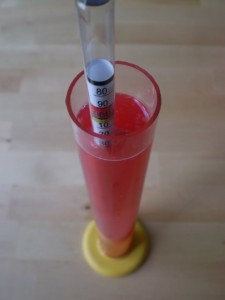When I was a kid, before I knew exactly what mead was, I associated it with vikings and long wooden tables and serving-wenches. Even then, I wanted to like it.
My associations were correct in that mead has been a popular drink in northern Europe since antiquity. The epic poem Beowulf, for instance, is about a dragon (Grendel) that terrorizes the mead-hall of a Danish king (Hrothgar) and that dragon’s subsequent ass-kicking at the hands of a young warrior (Beowulf). So yes, vikings and mead go hand in hand, but the drink is part of cultures far beyond Scandinavia, in Asia, Africa, Europe, and South America.
These days I’m trying to like mead for different reasons. Alberta has a relative abundance of quality honey, an almost complete lack of grapes (despite valiant efforts), and most of the fruits that are commonly used in home wine-making, like cranberries and chokecherries, require tinkering to get the acid and sugar levels right. Brewing with honey appeals to my snobby keep-it-local sensibilities.
I do have some reservations, though. What little mead I have tried, whether commercially-produced or home-brewed, has been thin, insipid, and completely lacking complexity. Maybe that’s just the nature of the beast. But I really want to like it, so I’m soldiering on with some home-brew.
This week I started two batches of mead. One is a mixture of honey and berries (called a “melomel” in mead-speak). Specifically, it is honey from a farm near Onoway, and raspberries frozen from last year’s u-pick bounty.
Raspberry Melomel
from The Winemaker’s Recipe Handbook by Raymond Massaccesi
Ingredients
- 2 1/2 lbs raspberries
- 2 1/2 lbs honey
- 3 quarts water
- 2 tsp acid blend
- 1/2 tsp pectic enzyme
- 3/4 tsp yeast nutrients
- 1 pack wine yeast
The second batch is honey and spices, a “metheglyn”. The mixture is infused with whole cloves, thin slices of ginger, and tea.
Metheglyn
adapted from The Winemaker’s Recipe Handbook by Raymond Massaccesi
Ingredients
- 3 lbs honey
- 7 pints water
- 6 bags Earl Grey tea
- 4 cloves
- 1/2 oz fresh ginger
- 3 tsp acid blend
- 3/4 tsp yeast nutrients
- 1 pack wine yeast
The melomel happily sped through primary fermentation, but the metheglyn was a little more ornery.
Problems with Metheglyn Fermentation
The initial specific gravity of my metheglyn must was above 1.100, which is well into dessert-wine sugar levels. This didn’t phase me, as I wanted my spiced mead to be sweet, reminiscent of mulled wine. Alarm bells should have been going off.
I used a Wyeast product specifically designed for sweet meads. I assumed it could handle the high sugar content, but a few days after pitching there were no signs of fermentation. I diluted the must to a specific gravity of 1.085, and twenty-four hours later, the must finally started to bubble. Next time I’ll try Sauternes yeast.
To sweeten this batch I’ll use the “süsse reserve” method, which is a fancy way of saying that I’ll add a bit of honey to the mead after fermentation has finished. There is some danger that fermentation could restart with the introduction of more sugar. Then I’d have sparkling mead, which actually doesn’t sound too bad. We’ll see.
